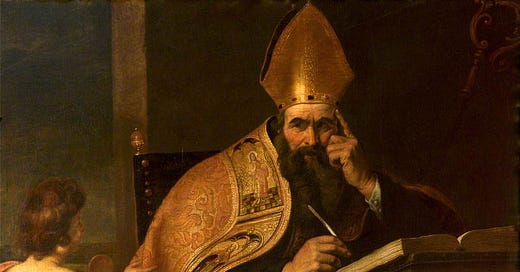n.b. This article is reposted from my personal book review blog.
Warning: this review contains spoilers.
In the aftermath of the sack of Rome by the Visigoths in AD 410, St Augustine wrote that mankind was split between two metaphorical ‘cities’. One was the ‘City of Man’, referring to the mindset of those concerned with materialistic, temporary things. The other was the ‘City of God’, which represented an eternal spiritual understanding gained through faith. Rome, Augustine argued, had met the fate of the City of Man. Yet the traumatised Romans could take heart in knowing that the spiritual City of God remained attainable, as its foundations already existed inside every person.
Augustine’s dichotomous vision of humanity is elegantly recreated in Walter M. Miller Jr’s unique sci-fi novel, A Canticle for Leibowitz. The book takes the form of three stories, set roughly 600, 1,200 and 1,800 years after a global nuclear catastrophe and a subsequent wave of anti-intellectual purges by the enraged survivors. It focuses on the monks of the Albertian Order of Leibowitz, a Catholic fraternal order who charged themselves with preserving scraps of written information from the pre-apocalyptic past.
As civilisation gradually rebuilds itself over the three stories, the Order becomes beset by debates between secular and religious authorities to determine who has the right to keep and use this precious knowledge. In the first story, where most of humanity is limited to scattered bands of hunter-gatherers and mutant bandits, the Church remains the sole keeper of fragmentary knowledge. The second story, set in Renaissance-esque period, sees this monopoly challenged by growing secular states and their hired academics, who are keen to apply the ‘memorabilia’ (as the scraps are known) to their own machinations. The final story shows the Order still clinging to the original memorabilia, despite the fact that secular forces outside the abbey have long since used their information to construct a technologically complex world that is, once again, teetering on the brink of self-annihilation.
The secular-clerical conflict at the heart of A Canticle for Leibowitz maps neatly onto Augustine’s paradigm of the cities. The secular authorities — typified in the second story by the figure of the atheist scholar Thon Taddeo Pfardentrott — are impatient to study the memorabilia, knowing that they can use its knowledge to further their immediate needs, namely military conquest. Their eyes are firmly set upon the City of Man, materialistic and temporary.
By contrast, the Order keeps the memorabilia cloistered because it remembers the danger that such knowledge can produce when applied to material ends. Successive abbots point to the martyrdom of Leibowitz, a twentieth-century nuclear scientist who was lynched because of his role in producing the knowledge that led to nuclear annihilation. Humanity cannot be trusted with such knowledge, so it falls upon those who choose a life centred on spirituality to preserve it until such a time that humanity can look beyond its material desires. Whether this is ever possible, Miller leaves uncertain.
As in real life, the conflict between matter and spirit appears uneven at first. At the beginning of the second story, we hear a papal ambassador comment that twentieth-century civilisation destroyed itself because it was ‘materially great and materially wise, and nothing else’. By the end of the story, the ambassador has been hung, drawn and quartered by a politically ambitious king. Secular power is fully dominant by the third story, with the abbey now surrounded by suburban homes and a multi-lane highway.
Yet, as the new global superpowers plan the next apocalypse, the Order prepares an escape route, placing a team of monks on board a spaceship bound for a distant colony planet, the memorabilia safely among them. The City of Man may be short-lived, but the City of God will last forever. In this ending, A Canticle for Leibowitz gets to the heart the Augustinian paradigm. Miller (a Catholic convert himself) understands that material concerns may seem to hold overwhelming power, but he reminds us that they are ultimately temporary. Real power lies in connection to a spiritual strength that is detached from the temporal rhythms of earthly life.
A Canticle for Leibowitz is not really a sci-fi novel. Despite some fleeting references to spaceships, its subject is primarily theological. This is a book about the inner struggle within humans, the contest between the competing forces of matter and spirit. Miller’s skill is that he can turn this monumental problem into three sharp, pacy stories, dragging the reader in and confronting them with Augustine’s ultimate choice.




